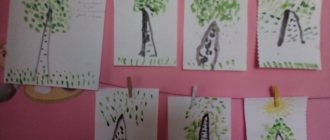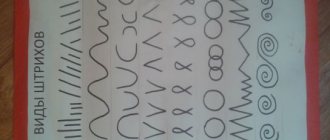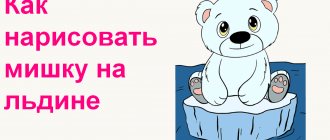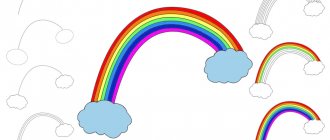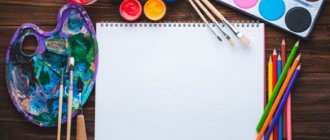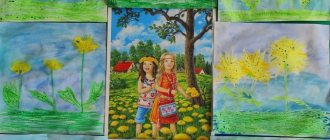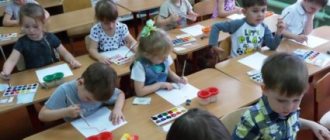GCD for drawing in the middle group Topic: “Apple-ripe, apple-sweet”
Guzel Sitdikova
GCD for drawing in the middle group Topic: “Apple-ripe, apple-sweet”
-Continue to introduce children to paint apple with gouache paints .
-Show the possibility of depicting half an apple (with colored pencils or felt-tip pens)
.
-Develop aesthetic perception, the ability to convey the characteristic features of an artistic image.
-Cultivate artistic taste.
Preliminary work: Didactic games “Fruits and vegetables”
,
“Guess the taste”
,
“Wonderful bag”
.
Reading the text by L. Tolstoy “The old man planted apple trees ”:
— The old man was planting apple trees . They said to him: “Why do you need apple trees ? fruit from these an apple from them .” The old man said: “I won’t eat it, others will eat it, they’ll thank me.”
Recommended teaching aids, clarity.
Posters "Fruit"
,
“Trees”
,
“Color.
Rainbow" .
Option with carved edges
Let's look at another way to draw an apple tree step by step with a pencil. In the fall, a child at school may be given a homework assignment to draw a fruit tree with fruits. The easiest way to depict an apple tree. A school-age child will be able to cope with the task of first drawing a large circle, then filling its contours around the entire perimeter with rounded corners. These are the leaves that are visible on the sides of the crown. They can be located either in one direction or towards each other.
The bottom space of a sheet of paper is filled with a thin trunk, which diverges into several branches closer to the crown of the tree. At the ground, the trunk also widens, ending in a winding line of roots. Fill the empty space of the crown with apples and leaves, distributing them evenly over the entire inner surface of the circle.
Progress of the lesson
Educator: Children, I’ll tell you a riddle, and you listen carefully and tell me the answer:
It fell from a branch,
It rolled and disappeared.
- And it didn’t disappear at all!
Yanik got it!
Guess what fell?
What was rolling? What's missing?
Children: Apple (If children find it difficult to say, then the teacher helps)
Surprise moment: Children, someone is knocking on our door. (The teacher opens the door)
.
The group includes a squirrel .
Squirrel: Hello children.
Children: Hello squirrel.
Squirrel: I came to you today with gifts, laying out apples of different varieties on the table. What do you guys think, what is this?
Children: Apples .
Squirrel: That's right, these are apples .
Educator: Well done guys. And now I suggest you look at the apples that the squirrel brought us. What shape are they?
Educator: How do ripe apples
Children: When ripe they are sweet, not when ripe they are sour.
Educator: And now I suggest you draw a ripe , juicy apple with a red side.
Educator: And now I will show you the sequence of work:
The apple is ripe , red,
Apple crispy,
I'll break the apple in half
an apple with my friend.
Educator: And now I will show you an apple , and I suggest you draw a cut apple from life with colored pencils.
Look at all the drawings with the children, invite the children to clean everything on their tables. And after cleaning, the design of the exhibition of children's drawings “Ripe Apples ”
.
Squirrel: Children, let's play the game "Wonderful Bag"
. This bag contains geometric shapes, you take the object with your hands and tell me what kind of object it is, without looking into the bag.
Children and Squirrel play a didactic game. After playing, Squirrel says goodbye to the children.
Squirrel: Goodbye guys.
Application “Apple” in the first junior group Thinking about something interesting for me to do with my kids, I decided to make with them this original application called “Apple”. For this one.
Application with design elements in the junior group “Apple for little hedgehogs” Application with design elements in the junior group “Apple for little hedgehogs”. Purpose of the lesson: to play out the fairy tale situation - division.
Summary of GCD for modeling “Apple, pear, plum” in the senior group, part I. Introductory. The teacher makes riddles about fruits. 1 riddle. This fruit is round, or rather spherical. It's small at the top.
Summary of an open GCD for speech development in the preparatory group “Retelling the story by V. Sukhomlinsky “The Apple and the Dawn” GCD Development of speech and reading fiction Topic: Retelling the story of V. Sukhomlinsky “The Apple and the Dawn” Goal: To develop speech.
Summary of a lesson on speech development in the senior group “Apple. Compiling a descriptive story" Summary of a lesson on speech development in a preparatory school group Topic: "Apple. Compiling a descriptive story" Correctional and educational.
Summary of a lesson on drawing with plasticine on the topic “Apple” (preparatory group) Summary of a lesson drawing with plasticine Topic: “Apple” preparatory group The lesson of modeling, drawing from plasticine “Apple” develops. Master class “Apple” Today, in honor of the “Apple Saved” holiday, I invited the children to make apples out of colored paper. Of course, everyone agreed and we got started. My art. Knitted napkin “Apple” Today I want to tell you about my old hobby - knitting. Knitting is perhaps one of the very first handicraft arts.
GCD “Wonderful Apple” Goal: to form cognitive interest in a person; introduce the organ of vision - the eye. GCD move: Educate. : Guys, before you know it.
Autumn Festival for children of the middle group “The Last Apple” “The LAST APPLE” 2015 Teachers: Zakharova Alexandra Nikolaevna, Tarasova Olga Nikolaevna. Children run on tiptoes to the music.
Source
Sailor dance “Apple”
It's time for physical education, as well as an introduction to Russian music: accordion, balalaika - everything is here! If the melody is familiar, then you can immediately start dancing or first watch the dance performed by professionals. I assure you, everyone’s mood will lift!
Let's get down to science and do some experiments. Look at the age of the children, some may need the help of an adult, others will cope with all the actions on their own.
Apple Volcano
This experience is the simplest and is suitable even for kids. Alexander and I started “exploding” volcanoes at the age of three, I. Remember that repeating experiments in different ways helps strengthen your understanding of the concepts being presented. Surprisingly, such simple ingredients cause a strong reaction in the child even now. So, we needed almost nothing:
- 1 apple;
- soda;
- apple cider vinegar (at the same time we’ll explain what it’s made from), of course you can also take white.
Everything is extremely simple. Cut a “crater” into the fruit. Ask your child to pour in soda and then pour in the acid solution in a stream. Be prepared to fill the container with ingredients a dozen times!
Why do baking soda and vinegar form bubbles? It is enough for kids to understand that these two products, when combined, cause a reaction. Older children can already be taught the basics of chemistry:
Baking soda and vinegar react with each other due to an acid-base reaction. Baking soda is sodium bicarbonate, and vinegar is acetic acid. One of the products that this reaction creates is carbon dioxide. This time we became acquainted with this phenomenon.
Will he drown or not?
I asked my son such a tricky question, placing a container of water and several apples in front of him. Alexander took them in his hands, assessed the severity and confidently answered: “They will drown.” Let's check!
Don't drown! You know why? The apple has air inside, which prevents it from descending completely. These fruits are less dense than water. Well, since they float, it’s worth making boats and playing.
What will save you from darkening?
Many people have noticed that cut apples turn dark. Oxidation occurs when the pulp comes into contact with oxygen and begins to react, turning brown. By the way, did you know that through genetic changes, varieties have been developed that remain white when cut? I have a negative attitude towards such changes, which are unknown how they will affect the genetics of our children decades later. Unfortunately, the stores do not indicate what exactly we are buying...
The experiment we are talking about will show how the pulp reacts to different environments. This required:
- Jars from Ikea (use any);
- pieces of fruit;
- salt;
- sugar;
- vegetable oil;
- vinegar;
- lemon juice;
- water.
I gave Alexander one option to choose from - he filled the jar with soda. Another container was left empty, without a lid - air.
Now let's wait, we did this for 2 days for a more obvious result. Then I took everything out, we looked at it carefully and touched it. The most surprising thing was the oil medium. In it, the slice remained quite light and absolutely hard, I would say crispy. I was also pleased with the salt - the color was preserved. It was she who amazed my little student. The lemon stopped the oxidation, but the flesh became very crumbly. Here I used apple cider vinegar, which I regretted; it colored the experimental piece.
Click on these two photos
What else can you do with children on the topic? Ours immediately came to mind in the form of an apple tree with fruits.
With this I say goodbye to you, my dear readers. I hope I was able to inspire you to do something similar. Use pictures, read books, conduct experiments - the main thing is that the learning process is interesting for children. Bye bye.
You don't have to be born a genius. It is enough to familiarize yourself with the technique of creating a drawing. Thanks to the step-by-step description, everyone will be able to understand how to draw an apple tree. And most importantly, you can teach your child this simple skill.
Notes on drawing “Ripe, red, sweet apple” in the middle group
Elena Kolesnikova
Notes on drawing “Ripe, red, sweet apple” in the middle group
Educator: Kolesnikova E.V.
Lesson notes on art activities in the middle group .
Drawing with paints (from life)
“
The apple is ripe , red , sweet .”
Goal: to teach children to create from nature and from imagination the image of a ripe , red apple .
1. Teach children to paint a multi-colored apple with gouache paints .
2. Show the possibility of depicting half an apple .
3. Develop aesthetic perception, the ability to convey the characteristic features of an artistic image.
4. Cultivate artistic taste.
Didactic game “Wonderful bag”.
Preview:
Lesson notes on fine arts (in the middle group)
Teach children to depict an apple using a means of expression: color, shape, size, correct location on the sheet.
Strengthen the skills of shaping movements and moving the brush along the pile.
Education of aesthetic perception of still life.
Examination and description of various fruits.
Examination of the still life by P. P. Konchalovsky “Apples on the table”
Materials, tools, equipment:
Gouache paints, brushes, cups, napkins, cardboard plates, palettes, apples according to the number of children, a bag, a Bunny toy.
Educator: Guys, look what I found! (showing the bag)
I’ll tell you a riddle now, and the answer is in this bag.
Adults love me
Educator: Well done! You have solved the riddle. There is an apple in the bag.
Educator: Guys, do you hear someone crying!
Interesting, I'll go and have a look. (the teacher brings in the hare)
Educator: Hello bunny! Why are you crying?
Educator: Look, Bunny, is this your bag?
Bunny: Yes! Where did you find it?
Educator: We found it here in the group, but there is only one apple.
Bunny: How come, where did the rest of the apples go?
Educator: Look, Bunny! There's a big hole in your bag. While you were running, you lost almost all the apples along the way.
Educator: I think I came up with it! Now the guys and I will draw apples. Are you a bunny living in a fairy forest? And there everything drawn turns into the real thing.
Bunny: Let's dance together!
Physical school
Educator: Well done! We had a lot of fun!
Let's help the bunny draw apples?
(Children sit at tables)
Educator: We will draw our apples on a plate. These plates are not simple, they are magical, as soon as they get into the fairytale forest, the painted apples will turn into real ones. To do this, we need to try and become artists.
Children: Artists paint pictures.
Ah, now I want to introduce you to the works of real artists who painted still lifes. A still life is a painting that depicts flowers, fruits, household items, and things that a person uses. These artists also depicted apples in their paintings.
(I put the bunny on the stand) Sit down, bunny, and listen carefully.
I. Khrutsky “Flowers and Fruits”.
Educator: Look carefully at this still life.
—What do you like most?
In this picture everything looks like the real thing. Beautiful flowers, juicy apples, velvety peaches, transparent grapes.
K.S. Petrov-Vodkin “Apple and Cherry”
Educator: Oh, this is a still life by another artist.
— How does this still life differ from the previous one?
Here the artist depicted only an apple and a cherry.
Cherry answers: “Yes, I am smaller than you, but very tender, my skin is transparent and thin. I am filled with aromatic juice. And my color is much brighter than yours. I have a deep scarlet color.”
An easy version of a children's drawing
The trunk lines extend slightly into the crown and have slightly rounded edges. The branches resemble a concave arc, which is located on the upper part of the trunk, which has a slight extension.
The kids will just have to draw a few large circles representing apples and add small tails to them. Pay attention to the kids that they should only be on top of the fruit, since the apple hangs on the branch. All that remains is to color the drawing.
Leave your comment
Responsibility for resolving any controversial issues regarding the materials themselves and their contents is taken by the users who posted the material on the site. However, the site administration is ready to provide all possible support in resolving any issues related to the work and content of the site. If you notice that materials are being used illegally on this site, please notify the site administration using the feedback form.
All materials posted on the site were created by the authors of the site or posted by users of the site and are presented on the site for informational purposes only. Copyrights for materials belong to their legal authors. Partial or complete copying of site materials without written permission from the site administration is prohibited! The opinion of the administration may not coincide with the point of view of the authors.
Source


